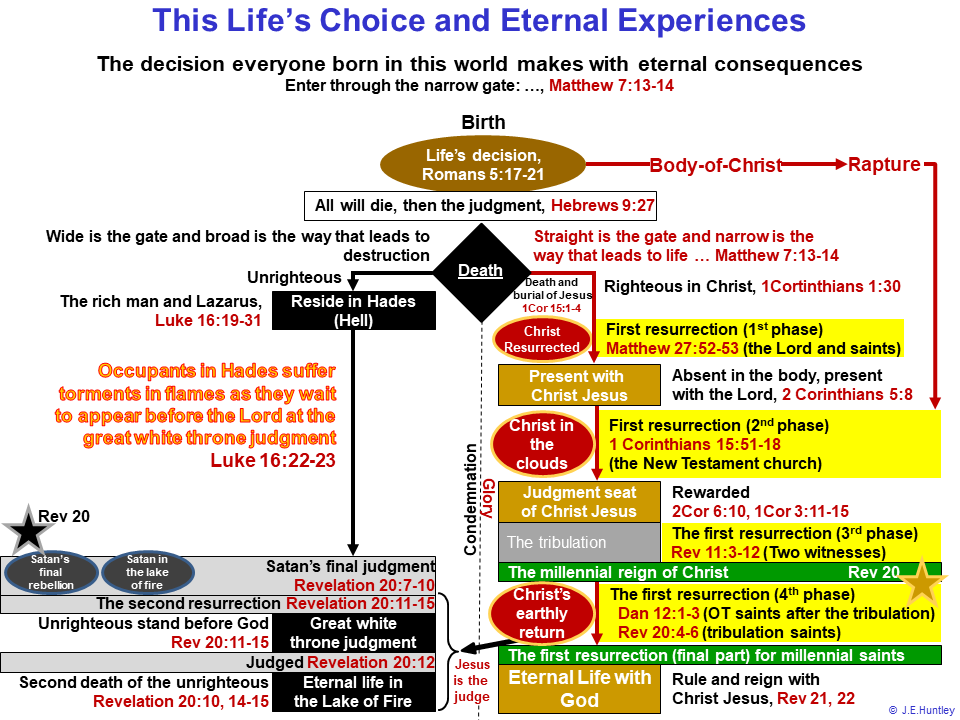Interpretations: The Mystery Program - Being Snatched away (Rapture)
The mystery of the snatch out, or being caught up when the Lord comes in the clouds to call for His church to come up to be with Him in the air. This event is not to be confused with the Lord’s magnificent return as King of kings, Revelation 19:11-16, when He returns to destroy His enemies, establish the first 1,000 years of His eternal kingdom, and sits on the throne of David. In the return of Christ Jesus, there are two separate events. The first is His return in the clouds to take His church from this world, second is His return in victory over His enemies. For the first event, there is no sign or prophecy that must be fulfilled before His first return can occur. His return for His church is always imminent. In contrast, numerous prophecies and events have been revealed that precede the Lord’s victorious return at the end of the seven years of tribulation. These two events are shown in the following graphic. The snatching away is an earlier event when He comes in the clouds to call up those who are His, the church, to be with Him forevermore, 1Thessalonians 4:13-17.
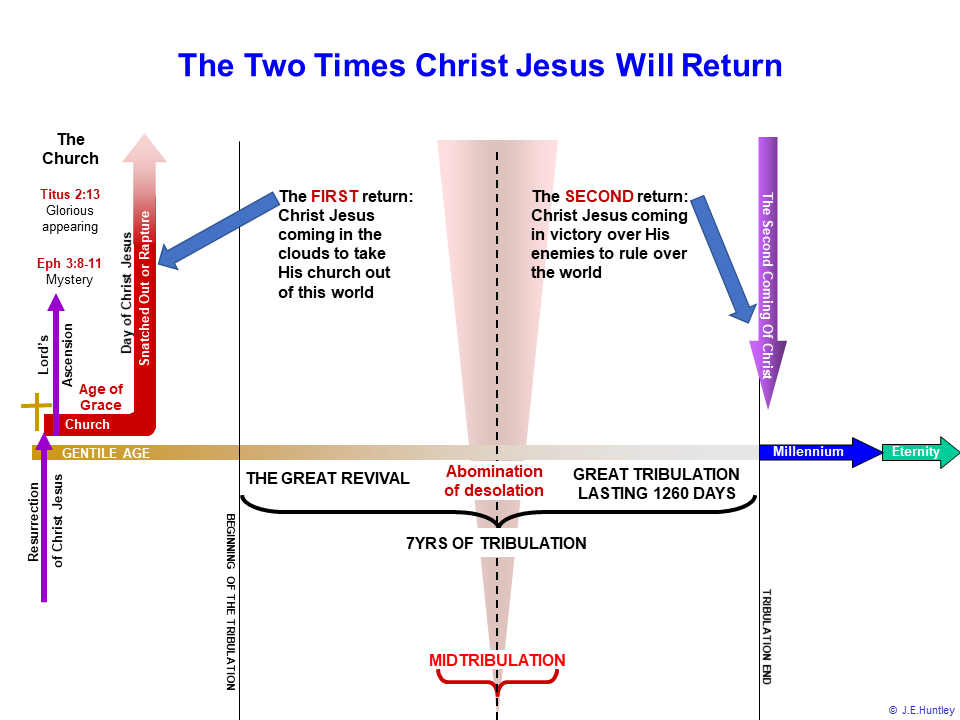
The term “church” as used in this section of this site, is the assembly of believers in Jesus Christ, which began with the apostles when on the day of His resurrection, when the Lord breathed the Holy Spirit upon them, John 20:22. The church builds further as Saul/Paul, began to spread the gospel to the Gentiles, and the Body-of-Christ also started, Acts 13:7-9, until the moment the Lord comes in the clouds, who is our blessed hope, Titus 2:13. This site treats the church as being in two parts. The first consist of believers in Christ Jesus in the Jerusalem church and its extension beyond Jerusalem, where Peter was the apostle to the circumcision, and then came the Body-of-Christ, with Paul being the apostle to the uncircumcision, Galatians 2:7-9. This snatching away is a two-part process. First, is the resurrection of the dead in Christ, 1Thessalonians 4:13-16. The dead in Christ are those believers who have died after the resurrection of the Christ Jesus, Romans 6:5. The second part is for those believers who are still alive in Christ when this event occurs. They will be caught up to the Lord in the air, better known as the rapture, to be with the Lord forevermore, 1Thessalonians 4:17. This is part of the overall set of promises Christ Jesus made to the church. The Greek word used in this passage for 'snatch out’ is harpazo, and its meanings are expressed in the Blue Letter Bible. There is an excellent sermon series on the rapture in 23 parts, by Dr. Andy Woods on YouTube. He provides a detailed and extensive study on the subject of the rapture, in 23, one-hour long sermons.
This site teaches that the Lord will come in the clouds at any moment to snatch His church out of this world. This event will occur before the beginning of the seven years of tribulation, as shown in the following graphic. The timeline is for emphasis on important Biblical events only, it is asymmetric in time. An accurate portrayal of time would show the length of time for the age of grace covering most of the eight-inch width of the page to represent approximately 2,000 years, and the length of time representing seven years of tribulation would be about one millimeter long. However, that sliver of time will contain the most devastating time the world will have ever known, or will ever know, Matthew 24:21-22.
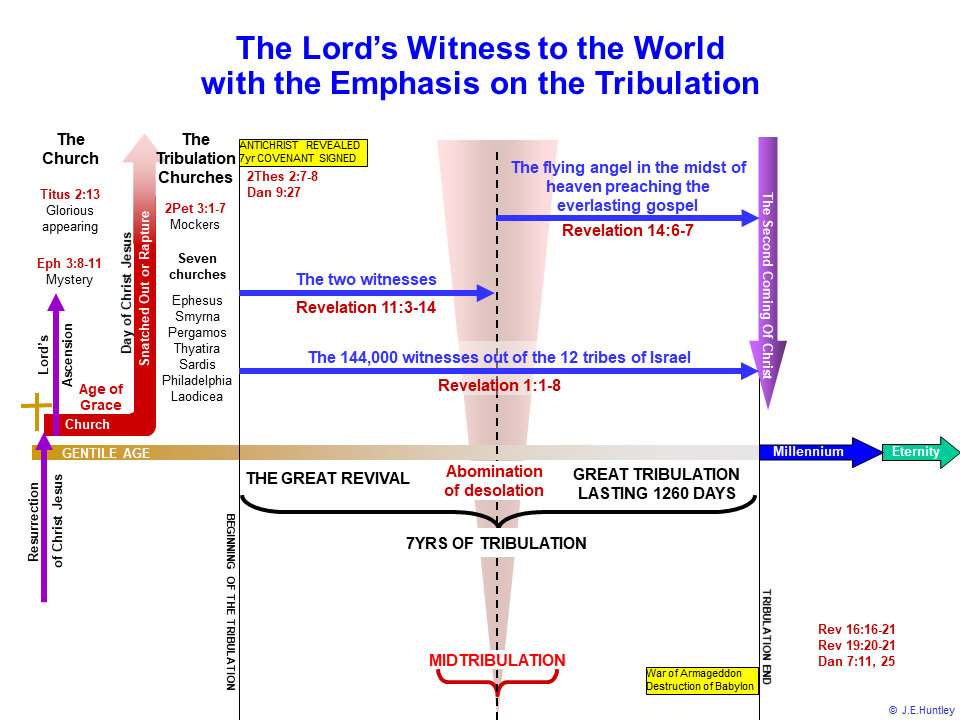
Other well-learned brothers and sisters in Christ have alternate views, which should not be the focus of great debates that lead to fissures within the fellowship in Christ. Rather, through respect and love, as the Lord commanded in John 13:31-35, the differences are acknowledged in this site.
For a further explanation of the snatching away, the resurrection of the dead in Christ will have their physical bodies changed into incorruptible bodies, 1Corinthians 15:50, 1Thessalonians 4:16. Their bodies will be joined with their soul and spirit, which had been present with the Lord upon their death, 2Corinthians 5:6-8. The resurrection of the dead is a long-held expectation of righteous believers of God, the oldest reference is found in the oldest book in the Bible, Job 19:26. Daniel prophesied that there would be a resurrection of the righteous and unrighteous, Daniel 12:1-2, as did the Lord during His earthly ministry, John 5:25-29. But not all Jews believed in the resurrection, such as the Sadducees, whom Jesus chided for their error, Matthew 22:23-30. The resurrection of the dead at the snatching away, are only for those who died in Christ after His resurrection. The other Old Testament saints will be resurrected at the end of the seven years of tribulation, Daniel 12:13, Revelation 20:4. The second part of the snatching away is for the believers in Christ who are alive when He appears in the clouds. These individuals will not taste death, but their bodies will be translated incorruptible, in the twinkle of an eye. They will then be caught up to also be with the Lord, 1Thessalonians 4:17, 1Corinthians 15:51-54. The following graphic illustrates these two parts of the snatching away.
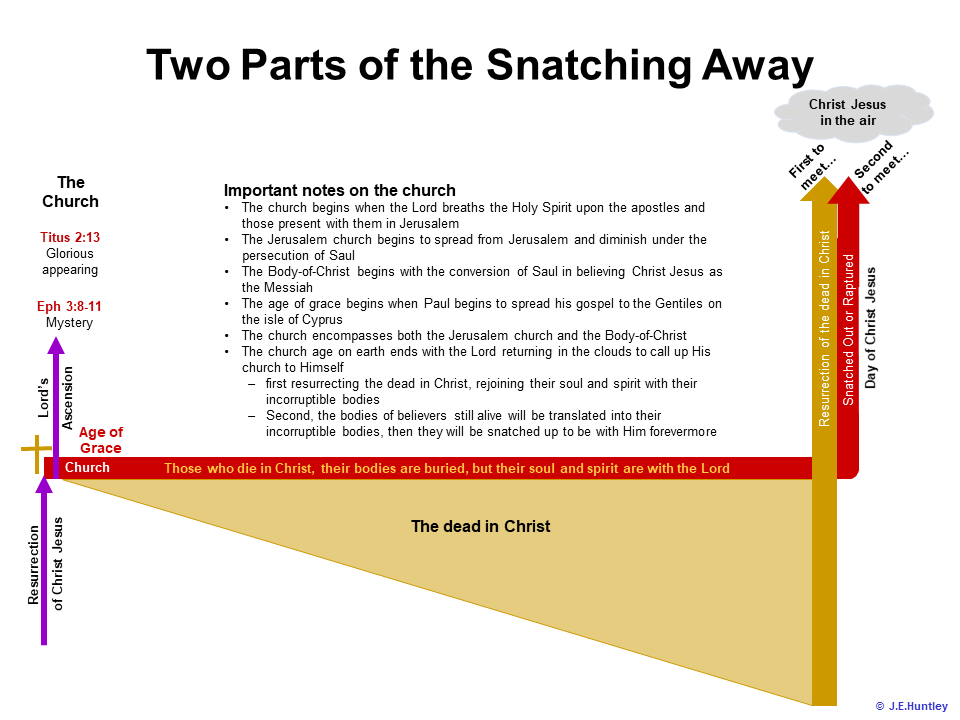
Several topics are discussed below to understand what the snatching away means and how it applies to the Body-of-Christ, what the church is, and a series of timelines provided and discussed to illustrate the event of Christ Jesus coming in the clouds for His church. There will also be a review of other beliefs concerning this event, which there are at least four variants. The timelines used below are further described in this site on interpretation of scriptures using timelines. The following table helps to provide a quick internal link on this section to jump to a specific subject, rather than scrolling down through the page.
The subject of the “snatching away” event is the church, in all its components. The church will be gathered together to be with Christ Jesus for evermore, 1Thessalonians 4:16-17. In its contextual sense, when Peter confessed that Jesus was Israel’s Messiah, Matthew 16:15-19, the Lord said that based on this statement of Peter’s faith, Jesus would build His church and the gates of hell would not stop its spread throughout the world from its inception in time, onward until the time the Lord returns to call the church up to Him, 1Thessalonians 4:14-18. The Blue Letter Bible shows several usages of this word “church.” From a Christian perspective, it can mean an assembly of believers in Christ Jesus gathered for worship. This includes both believers, either believing Jews or Gentiles, who are alive and scattered throughout earth, and those believers in Christ already dead. Those believers in Christ who have already died have their bodies buried in the ground but their soul and spirit in the presence of the Lord, 2Corinthians 5:8. More is written on the church in the dispensation section in this site.
Christ Jesus began to build His church from what He started with the nation of Israel. In the days of Abram, God called him out from the rest of mankind to establish him and his earthly descendants to be a blessing to all mankind, Genesis 12:1-3. They were to be set apart and not numbered with any of the other nations, Numbers 23:9. In the days of Moses, God led Israel to the base of Mount Sinai, where He met with them and told them that they were to be a nation of priests, Genesis 19:6. Unlike any other nation on earth, Israel entered into a covenant with God for them and all their future generations, under the law, Exodus 19:3-8. God set them apart for His purposes, Exodus 19:6. In the future dispensation of the kingdom, the nation of Israel will be a bright light to all the nations, Isaiah 60:1-3. At that time Jerusalem shall be called the Throne of the Lord and all nations will gather to it, Jeremiah 3:17. Nevertheless, during the Lord’s earthly ministry, He selected 12 individuals from the nation of Israel to be His apostles, to go throughout the nation of Israel only, preaching that the kingdom of heaven was at hand, Matthew 10:1-7. Luke wrote that the Lord told His apostles to seek the kingdom of God and their needs on earth would be met, Luke 12:29-31. Afterward, He called them His “little flock,” to whom it was the Father’s good pleasure to give them the kingdom, Luke 12:32. The little flock, or church, had not begun, but Jesus was looking forward to the day of its formation after His resurrection, when He breathed the Holy Spirit upon them, John 20:22. They were told by the Lord to tarry in Jerusalem until they were endued with the power of the Holy Spirit, Luke 24:49. They would then be led by the Holy Spirit to reach out to the nation of Israel and again preach the gospel of the kingdom.
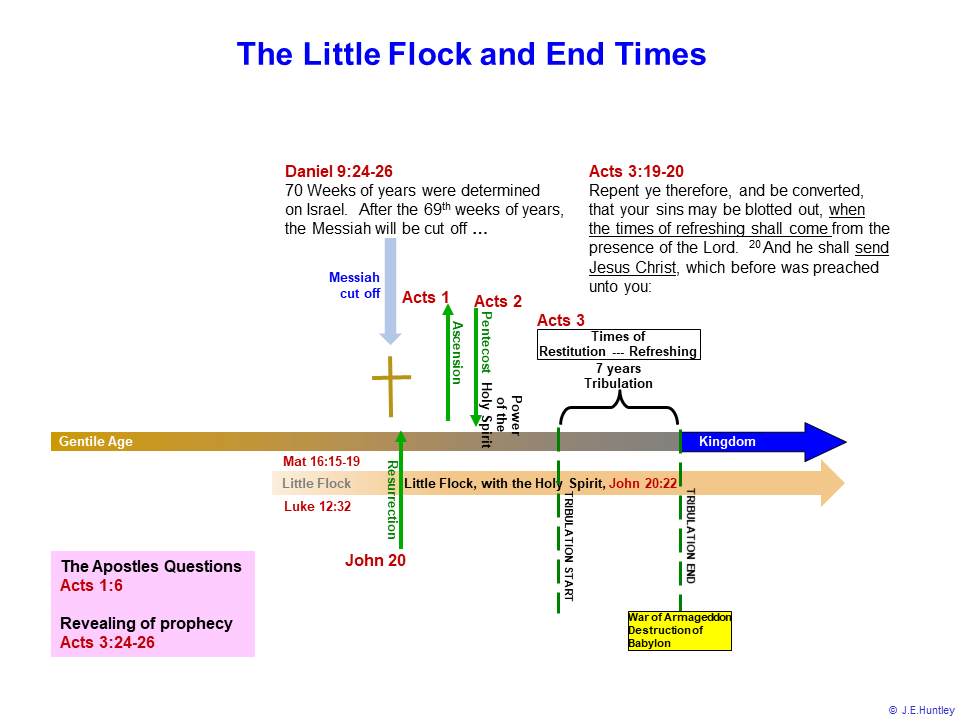
Richard Jordan points this out in his book how the Lord trained His little flock to carry the message of the kingdom gospel to Israel and on into the world to fulfill His great commission to them, Mark 16:15-18, Acts 1:8. These 12 apostles were promised that in the kingdom age, they would be sitting on 12 thrones judging the 12 tribes of Israel, Matthew 19:28. All the preparation of the Lord and His instructions for his apostles are written in the four gospels in Matthew, Mark, Luke, and John.
The night Jesus was betrayed by Judas Iscariot, Jesus revealed something that had not been shared to the nation of Israel at any time. After Judas left to betray Jesus, the Lord told His remaining 11 apostles, that He was leaving to prepare a place for them, and would return to receive them so that where He was, there they would be also, John 14:1-4.
Within the prophetic program of Israel, Israel would go through seven years of tribulation, then the kingdom would come and they would enjoy all the promises, fulfillment of the covenants and promises God had made to them, Daniel 9:24-26, 27, Isaiah 24:1-13, Jeremiah 3:16-18, 30:4-7. A remnant of Israel will survive the tribulation, Isaiah 26:16-21, and they are the ones in their physical bodies who will transition directly into His kingdom on earth. Those who were taken up to be with Christ will return with Him as the Lord establishes His millennial reign on earth. Then the righteous Old Testament saints will be resurrected with their incorruptible bodies to enjoy the fulfillment of all God’s promises to them, Isaiah 25:1-6, 60:1-7, 65:18-25, Job 14:10-14.
At the time the Lord announced this new revelation concerning a place he was preparing for them, the apostles had already spent three years announcing the gospel of the kingdom was at hand; in complete harmony with all that had been prophesied since the world began, Acts 3:19-26, and what Jesus spoke of on His Olivet Discourse, Matthew 24. The apostles’ professed Jesus was the Messiah prophesied in times past, John 6:68-69. The following graphic illustrates the believing Jew’s concept of events leading up to the kingdom age. There was nothing revealed to them that there would be a break of about 2,000 years in their timeline for the dispensation of grace, as revealed to Paul. This view of the early Jewish believers concerning the end times is distinct from what was promised to the Body-of-Christ. The apostle Paul is the only person in scripture to write about the “Body-of-Christ,” consisting of both Jews and Gentiles. The Body-of-Christ did not come into existence until Paul believed in Christ Jesus as the Messiah on the road to Damascus, Acts 9:5-20. Paul was the chief, or first to be in the Body-of-Christ, 1Timothy 1:15. There will be a segment of the Body-of-Christ who will be alive when the Lord returns in the clouds. These believers in Christ Jesus will not experience death, 1Thessalonians 4:13-18. The Lord made no promise to the early Jewish believers that they would not experience death. Their view of the end times, as shown in the previous graphic, differed from what Paul taught since the dispensation of grace had not been revealed to them.
The apostles did not understand what the Lord told them as Jesus made His last walk to Jerusalem, that He would be rejected by Israel, and be put to death, and on the third day rise, Luke 18:31-34, Mark 10:33-34. So, instead of walking into the kingdom age as they expected, Matthew 24:3, Acts 1:6, even after the day of Pentecost, Acts 3:19-21, the Lord told them that he would take them from this world to be where He was, John 14:2-3. The Lord revealed a lot of information to the apostles in His final days before His death, but they simply did not understand. But the description Jesus gave the apostles that night after Judas left to betray Him, was a great promise and was to be comfort for them. The details in John 14:1-4 are the same that was revealed to Paul for the Body-of-Christ, 1Thessalonians 4:13-18. Both passages show that the Lord will descend from heaven and the dead in Christ will rise. Both passages show that we will both be with the Lord where He is. Both passages speak on the believers in Christ Jesus being comforted by this future event promised by the Lord.
There are four important facts to consider when reflecting on this passage of scripture, John 14:1-4. First, this promise was directed to the apostles who were present with Him in the upper room, and to those believers who would follow after the Lord’s resurrection until He returned for them, John 17:20-24. This promise was not inclusive of the entire nation of Israel, those who had lived and died before the Lord’s resurrection.
Second, in preaching the gospel of the kingdom, all of the prophecies indicate that the kingdom would be established and Israel would immediately be part of it. This was congruent with the Hebrew customs of the engagement and marriage ceremony in that day, particularly in the area of Galilee where the remaining apostles came from. This custom is demonstrated on Brent Miller Jr’s, “Before the Wrath,” which provides an excellent overview of the entire process and how it relates to the Lord’s return for the church. As a bridegroom would tell his bride at the gate of the city to initiate this lengthy process and tell her he would prepare a place for her, Jesus told His apostles that when He went away, sitting at the right hand of the Father, Acts 2:32-33, He would prepare a place in His Father’s house and return for them. He did not tell them that the kingdom would come first. Instead, though not explicitly stated but in hindsight, when He returned for them, they would be resurrected in their eternal bodies to be with the Lord, John 14:3, 1Corinthians 15:48-50. When the Lord returns in the clouds for His church, the little flock will be taken up, in the first part, the resurrection of the dead in Christ. The resurrection has been an essential, long held expectation of righteous believers of God of future things. The oldest reference to the resurrection is found in the book of Job, Job 14:10-14, 19:26. God declared Job was righteous, Job 1:8. Daniel prophesied that there would be a resurrection of the righteous and unrighteous, Daniel 12:1-2. Martha also witnessed her belief of the resurrection in the last day when she confessed Jesus was the Christ, the Son of God, John 11:23-27. These are a few examples of Israel’s understanding and expectation for a resurrection.
Third, the Lord did not say they would be alive when He returned. In other words, the apostles were not told to expect to have their bodies translated in the twinkling of an eye and snatched up to be with Him, as the Lord revealed to Paul to be promised to the Body-of-Christ, 1Corinthians 15:51-54. The events for the little flock and the Body-of-Christ are tied together, as both entities constitute the church, as explained below.
Fourth, Jesus promised them that after the place was prepared by the Lord for them, that Jesus would return to receive them unto Himself. Where the Lord was, they would be there also, John 14:2-3. The Lord told them that they knew the place He would go and the way He would go they knew, John 14:4, they just did not understand at that moment, Luke 18:34. But the Lord assured them that after He ascended to the Father, the Holy Spirit would be with them and remind them of all the Lord told them, John 14:26.
There is a great debate on when the church began. The position taught in this website is that the church began the day of Christ Jesus’ resurrection, in the evening, when He appeared to the apostles who were hiding from the Jews, and He breathed the Holy Spirit on them, John 20:21-22. Paul wrote that if we believe on God who raised up Jesus our Lord from the dead, that His righteousness would be imputed upon us, who was raised for our justification, Romans 4:23-25. The 12 Apostles plus Jews present who believed Jesus was their Messiah, would receive the power of the Holy Spirit on the day of Pentecost, Acts 1:4,8. At the beginning of the church until Saul believed on Christ Jesus as the Messiah, the church was Jew only, Acts 11:19. These believing Jews met daily in the temple, breaking bread from house to house, Acts 2:41-47. Any non-Jewish person who wanted to be part of the church, before Paul’s ministry and steward of the dispensation of grace, had to be converted to Judaism, Acts 15:1.
As the apostles reached out to Israel after the Lord’s resurrection and ascension, the nation rejected the message of the Holy Spirit three times. The first time occurred when Peter and John were arrested by the Jewish authorities, and they appeared before the Sanhedrin, Acts 4:1-22. At that time Peter will filled with the Holy Spirit and spoke boldly to the rulers of the people and elders of Israel, Acts 4:8, 13. The second time was when all 12 apostles were arrested by the high priest and the Sadducees, Acts 5:17-42. This time, the apostles all responded that they had to obey God rather than men, Acts 5:29-32. The third time was when Stephen spoke to the Jewish leadership by the power of the Holy Spirt, Acts 6:15-Acts 7:1-60. As Jonathan Cahn wrote in The Harbinger II, The Return, “the words of kings determine the fate of nations,” such as David’s sin causing the death of 70,000 men of Israel, 1Chronicles 21:15-17. As a result of this third rejection by Israel’s leadership, Israel fell and the work of the little flock diminished, Romans 11:11-12 (KJV), and then Saul commenced his relentless persecution of the church. This persecution forced Jewish believers in Christ Jesus to flee Jerusalem. As they dispersed to other regions, they preached the Word to Jews only, Acts 11:19.
The fall of Israel and diminishing of the little flock is not a permanent condition, but temporary until after the Lord returns to call His church to Himself, Romans 11:11-12, 22-25. In the meantime, the Lord raised up a man, Saul to take the gospel of salvation, 1Corinthians 15:1-4, to the Gentiles, Acts 9:10-16, Galatians 2:8. Through Saul (later Paul, Acts 13:9), the Lord would take out for Himself a people for His name among the Gentiles, Acts 15:13-14. Paul is the apostle to the Gentiles, Romans 11:13, Galatians 2:8. The Lord revealed to Paul the hidden mysteries, ordained before the world began, 1Corinthians 2:7, Colossians 1:25-26. During the dispensation of grace, Ephesians 3:2, all of the revealed mysteries to Paul are manifest. The dispensation of grace is in affect today, until the day of Jesus Christ. That is the day He will call his church to Himself in the clouds to be with Him forever more, 1Thessalonians 4:13-18. Once the church has been called away from this world, then the prophetic program of Israel will resume.
The “church,” whom the Lord is coming in the clouds for, consists of the little flock, which was the Jerusalem church led by the 12 apostles, and the Body-of-Christ, where Paul was the apostle to the Gentiles, Romans 11:13. Paul is the only person in all of scripture to define and use the phrase “Body-of-Christ.” Paul, who was a Jew and Pharisee, was chief, or the first among believers, into the Body-of-Christ, 1Timothy 1:15. As a Jew, he was among the top of his peers, Philippians 3:4-6. However, because of his apostleship to the Gentiles, he told the believing Gentiles to follow him, 1Corinthians 4:14-16, 11:11. During the dispensation of grace, both Jew and Gentile believers make up the Body-of-Christ, there is no distinction between them, both are one in the Body-of-Christ, 1Corinthians 12:13, Galatians 3:27-29. The Body-of-Christ began with Paul’s belief in Christ Jesus as His Messiah, and the end of the age for the Body-of-Christ is when the fulness of Gentile believers come in, Romans 11:25, then Israel will begin to believe, Romans 11:26-29, and the Lord will again build the tabernacle of David, Acts 15:14-17.
Further, the Body-of-Christ is constituted with believers in Christ Jesus who have already died, and believers in Christ who will be living at the time the Lord calls for the church from the clouds. The latter group will experience the snatching away, also known as the rapture, 1Thessalonians 4:17. This is the mystery that Paul spoke of. The others in the church who have died believing in Christ, both those led by the 12 apostles and those in the Body-of-Christ, will be resurrected first and taken up to be with the Lord, John 14:1-4, 1Thessalonians 4:16. The resurrection is a common understanding found throughout scripture, but it is the snatching away, or rapture, that had been kept secret until it was revealed to Paul.
The following graphic provides a brief summarization of the forgoing information on the church from the death, burial and resurrection of Christ Jesus to the day of the blessed hope, Titus 2:11-14, when the Lord returns in the clouds, Acts 1:9-11, to snatch away His church, those dead in Christ and those still alive who believe in Christ Jesus, 1Thessalonians 4:13-18. The dark brown area represents the growth of the little flock, or church in Jerusalem, and its decline. The blue area represents the building of the Body-of-Christ, beginning with Paul, ending with the “fulness of the Gentiles,” Romans 11:25, when the last Gentile believes in Christ Jesus in the dispensation of grace. The purple area illustrates the events that make up the day of Jesus Christ.
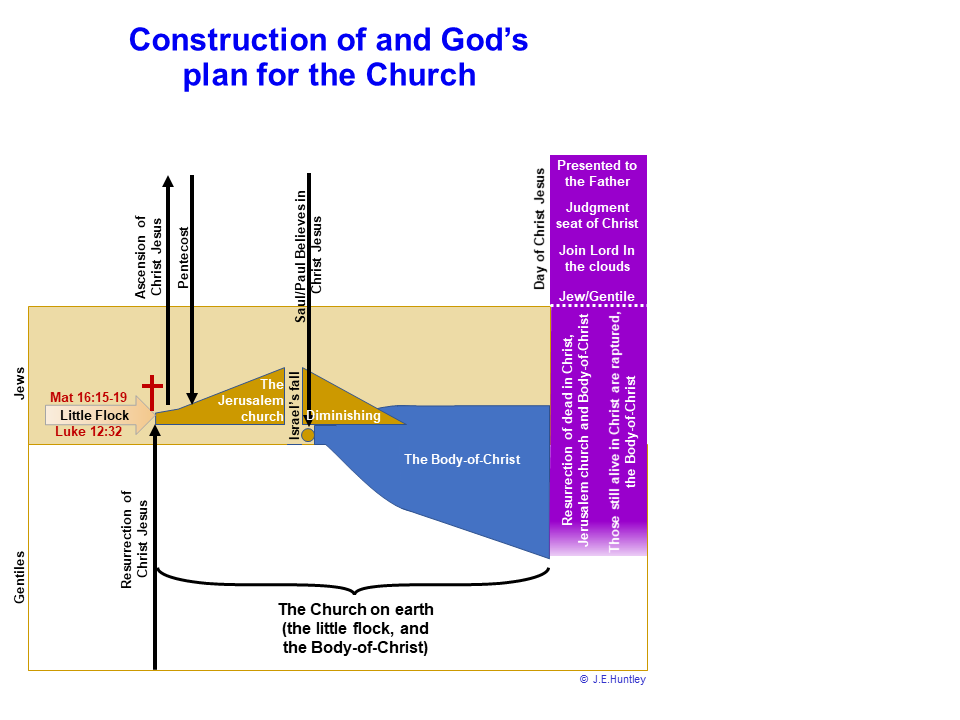
In summary, the term “church” as used in this section of this website describing the dispensation of grace, alludes to the assembly of believers in Christ Jesus. The timeframe begins with the Jewish believers in Christ Jesus who were alive at the ascension of Christ Jesus (the little flock), it includes all Jew and Gentile believers who died since then who were under either the ministry of Peter or Paul, Galatians 2:7-9, and those in the Body-of-Christ in the future who will be alive when the Lord returns in the clouds to call up His own unto Himself. That day of His glorious appearing, Titus 2:13, the dispensation of grace will end, and be replaced by dispensation of the kingdom, which begins in judgment of the world.
Within the body of scripture, there has always been a distinction made among all mankind, Jews and Gentiles after the calling out of Abram from his country, Ur of the Chaldees, Genesis 15:7, and family, Genesis 12:1. In today's economy in the dispensation of grace, there is no distinction made between Jew and Gentiles, we are all one in the body of Christ, Galatians 3:26-29. During the dispensation of grace we now live in, the distinction by God among people in the world are believers in Christ Jesus (Jews and Gentiles), Jews, and non-believers. This distinction is vitally important, as it relates directly to God’s grace given to the Body-of-Christ through His Son’s redemption by His blood, and through our faith in His work on the cross. This is the only way for salvation today for all mankind, 1Corinthians 15:1-4.
In the Old Testament economy, before the resurrection of the Lord Jesus Christ, Israel was given many promises from God through the Law of Moses, the prophets, and the Psalms. Those promises concerned the Lord’s first and second advents, the establishment of the kingdom of God with Christ Jesus sitting on David’s throne, and Israel would be a light to all the nations, Isaiah 60. Before the establishment of this kingdom, the Lord revealed to Daniel by the angel Gabriel, that 70 weeks were determined for Israel, Daniel 9:21-24. During that seventy weeks, six specific acts were to be accomplished, (see Daniel 9 for more information). In the last week of the 70 weeks (equivalent to seven years), is the time of tribulation, Daniel 9:27, (see Daniel 9 timeline for more information). This will be the worst time in all human history, even more devastating than the horrors and evil of Hitler during WWII, Daniel 12:1. This is the time that the Lord repeated in His warning to Israel when he quoted Daniel, Matthew 24:15-28. Immediately after the seven years of tribulation, the kingdom of the Lord will be established on this earth, Matthew 24:29-31. There is no reference in the Old Testament scripture concerning “snatching away (rapture),” as Paul described in 1Thessalonians 4:13-18, 1Corinthians 15:51-54. There are ample passages describing the resurrection of the Old Testament saints, such as in Job 19:25-27 and Daniel 12:2, and that in their resurrected state, they will attain those things which the Lord had promised them such as their inheritance of the land God promised Abraham, Hebrews 11:8-16.
All that the eleven apostles knew the night Jesus was betrayed, and were promised, was that the Lord was preparing a place for them and that He would return and receive them to Himself, John 14:1-3. The Lord did not attach this promise to His return to establish His kingdom at the end of the tribulation, Zechariah 14:4. As mentioned in the previous section, this promise of Christ Jesus to His apostles is tied to the blessed appearing of the Lord, Titus 2:13, when the resurrection of all the dead in Christ will occur. The Lord gave no indication that any believer in Christ would have the experience in their body as Paul wrote in 1Corinthians 15:51-54. They were expecting the Lord to return physically and establish His kingdom on earth, even in their lifetime, Acts 3:19-212. They did not expect that they would die, be resurrected to go up and join Christ Jesus in the clouds, be with Him in the presence of God’s throne through the tribulation, and then return with Christ Jesus as He established His kingdom on earth at the battle of Armageddon. In the Jewish mind, there was no Body-of-Christ, nor a snatching away (rapture) that was expected or thought of for the corporate body of believers in God withing Israel. There were only two exceptions of individuals in the Old Testament who did not die, but were taken up to be with the Lord. The first, a non-Jew but in the genealogical line that led to Jesus was Enoch, Genesis 5:24. The second was Elijah who was taken up in a fiery chariot, which Elisha witnessed, 2Kings 2:11-12. These were exceptions to the revealed truth the Lord revealed to Israel. Israel was given several prophecies that told them there would be seven years of tribulation and then the kingdom of God would be established, as shown in the following graphic.

The rapture of the church is more appropriately termed the “snatching away” of those who have believed in the Lord Jesus Christ for their salvation through His shed blood on the cross, Ephesians 1:7, Colossians 1:12-14,20, Romans 6:23. This is a discrete event that is yet to occur, and the time of this event is not tied directly to any other prophetic event in scripture. It is an imminent event, something that can occur at any moment, ever since the ascension of the Lord into the clouds to be on the right side of the Father in heaven, Acts 1:4-11. The “snatching away” describes an event when the Lord will return in the clouds, just as He ascended in the presence of the 11 apostles. At that moment, two angels appeared to the apostles and indicated that this was the manner of Christ’s return for them, Acts 1:9-11. This is not His return in victor over His enemies, Revelation 19:11-16, but when He returns in the clouds to call His own up to Him in the air to be with Him forevermore, 1Thessalonians 4:17, as seen in the following graphic.

At that moment He returns in the clouds, He will shout with the sound of a trumpet and first, all who have died in Christ will be raised in their resurrected bodies. Then, those who are still alive and are in Christ, will be translated and will meet the Lord Jesus Christ in the clouds and forever be with Him, 1Corinthians 15:51-58, 1Thessalonians 4:13-18, (see 1Corinthians 15 and 1Thessalonians 4 on this website for more information).
The word itself, rapture, is not found in scripture. Instead, it is a variant from a Latin word used in the Latin Vulgate. It is a rendering from the Greek word in 1Thessalonians 4:17 “harpazo” which in English is “caught up.” In the Blue Letter Bible, harpazo (Blue Letter Bible. "1 Thessalonians 4 - King James Version." Blue Letter Bible. 1996-2008), has three definitions: 1) To seize, carry off by force, 2) To seize on, claim for one’s self eagerly, or 3) To snatch out or away. All of these definitions imply an event that is quick, not an anticipated event in time, and has permanence in the completion of the action.
The church is that entity in scripture who receives the fulfillment of the promise by the Lord to return in the clouds to call all who are His to Himself, 2Timothy 2:19. He will descend from heaven with a shout, with the voice of an archangel, with the trump of God. Instantly, the dead in Christ (believers in Christ Jesus as Lord), will rise from the dead, both those who were the little flock, and those in the Body-of-Christ, John 14:1-4, 1Thessalonians 4:16. Next, believers who are alive at that same moment, will change in the twinkling of an eye and their physical bodies will be changed to eternal, incorruptible bodies, 1Corinthians 15:52-54, 1Thessalonians 4:17. Those believers whose bodies were changed, are the ones Paul wrote will be “snatched up”, or raptured, into the clouds, to meet the Lord in the air, to be with Him forevermore, 1Thessalonians 4:17-18. This will all occur before the tribulation when God’s wrath will be poured out on the world, because the church is to be kept from that wrath to come, 1Thessalonians 1:10, Romans 5:9.
In the revelation of Jesus Christ, that was revealed to John, Revelation 1:1, several events took place in rapid succession that paralleled the mystery of the Lord’s return in the clouds that were revealed to Paul. John saw a door before him, open in heaven, and he heard a voice speaking to him like a trumpet saying “Come up here … Meta Tauta”. At once, he was in the Spirit was before the throne of God. The implication is that John as a representative of the church in Jerusalem, Galatians 2:7-9, and being one of the early church fathers, was taken up to be in the presence of the Lord.
A similar event occurred when Moses and the children of Israel stood before the base of Mount Sinai, Exodus 19. After three days, Israel was instructed to consecrate themselves for this great event, and they observed several events that John observed in heaven before God’s throne Revelation 4:1-2. There was thunder, lightning, a thick cloud over the mountain, and a very loud trumpet blast, Exodus 19:16. The mount was covered with smoke as the Lord descended on it in fire, and the whole mountain trembled violently, Exodus 19:18. The sound of the trumpet grew louder and louder, then Moses spoke and the voice of God answered him, Exodus 19:19. The Lord descended to the top of Mount Sinai, and called Moses to the top of the mountain. In Johns observation, there lightnings, thundering, and a multitude of voices. God’s throne room is a very noisy place, abounding in praises to Him, Revelation 4:5, 8-11. There are other references to a shaking on earth and in heaven, Hebrews 12:26-27, clouds Revelation 11:12, 14:14-16, and smoke from the glory of God and His power that filled the temple in heaven, Revelation 15:8.
The account at Mount Sinai was a singular and defining event in the history of Israel. Moses, having gone up and down the mountain several times as a man, ended up coming down with the “LAW”, but the men and women of Israel were not regenerated into what we call the “new man” in Christ. Instead, they invoked God’s judgment on them so that only Caleb and Joshua were allowed into the promised land out of all those who came out of Egypt, 20 years and above, Numbers 32:11, Hebrews 3:8-11. Scriptures show Moses as a great man, Hebrews 3:5, very meek above all the men, Numbers 12:3, and a servant of God, Joshua 1:13-14. He was called by God at the burning bush on the same mountain that God would lead Moses and the children of Israel back to and where Moses would serve God, Exodus 3:4-5, 12. God did call Moses up to Him at the top of the mount, and some associate this with the rapture, but it does not have direct relevance to the “snatching away” of the Body-of-Christ. When Christ Jesus comes in the clouds to call His church to Himself, this will happen once. Moses was called up to the presence of the Lord on top of the mountain several times. And though the face Moses glowed because he was in the presence of the Lord, he wore a veil to cover his face because of the fear of the people, Exodus 34:28-35. Paul referenced the veil on the face of Moses as an example to the Body-of-Christ, that the ministration of death is written and engraved on stone, but the Spirit gives life, 2Corinthians 3:3-14. There was no anticipation of a future snatching up of the Body-of-Christ (which is written in the epistles of Paul as a mystery now revealed to the New Testament saints) in these events at Mount Saini, but they serve as examples to us today, Romans 15:4.
Enoch also was taken up by the Lord a good while before the worldwide flood in Noah's day, Genesis 5:21-25. Elijah too was taken up into heaven with Elisha as witness, 2Kings 2:9-13. The mysteries concerning the Lord returning in the clouds to call up His church to Himself, or the snatching away of the Body-of-Christ were not revealed until after the apostle Paul was converted to believe that Christ Jesus is the Messiah. That revelation was done in God’s time, Daniel 2:28-30.
When the apostle John heard the words of Christ to “come up”, he was instantly translated in the spirit, and not as a natural or physical man. John saw the representation of the church before the throne of God in Revelation 4-5, and other chapters in Revelation, where 24 elders worshiped God before His throne. They were sitting on thrones, clothed with white raiment, wearing crowns of gold on their heads, Revelation 4:4. From Revelation 4 through Revelation 18, the church is not shown to have any part of the events on earth, but is only seen participating in the heavenly events from this chapter on to the end of the book, as represented by the 24 elders.
There are two parts of the Lord’s return, first is when the Lord returns in the clouds to call up His church to Himself in the air. The second is the Lord's return as King of kings. The first part is directly tied to the catching up the Body-of-Christ to Himself in the air, 1Corinthians 15, 1 Thessalonians 4, Titus 2, and other books in the Bible. The second part of the Lord's return is found in Revelation 19 and Revelation 20, where He returns as the King of kings to establish His millennial kingdom. The events recorded in Matthew 24:42-51, directly concern the Lord’s return to establish His kingdom, when He returns in judgment and power. There may be a dual application in these passages, and may also serve as warnings to the church to watch for the rapture, but the primary application is toward the nation of Israel in preparing for the Lord's return as King of kings. There are no signs or prophetic events given to the church as to when the rapture will occur, only that it will occur suddenly. No one knows the day that the Lord will come, Matthew 24:42. We are told to be as the faithful and wise servant, Matthew 24:45.
The first part of the Lord's return is the rapture of the church is found in 1Thessalonians 4:17. The Greek word used in this verse, “harpazo” which in English is “caught up” distinguishes the two parts of the Lord's return. In this passage, Paul reveals that this is when the Lord comes down with a shout to call His church unto Himself. The Blue Letter Bible. "1 Thessalonians 4 - King James Version." Blue Letter Bible. 1996-2008), provides the meaning of and the usage of the word harpazo, as discussed above.
The second part of the Lord's return, to establish His kingdom on the earth, is found in 1Thessalonians 3:13 “Parousia” when Christ returns with His saints to the earth. The Blue Letter Bible, (Blue Letter Bible. "1Thessalonians 3 - King James Version." Blue Letter Bible. 1996-2008), provides the meaning of and usage of the work “parousia.” Parousia has two definitions; 1) presence, and 2) the coming, arrival, advent, 2a) the future visible return from heaven of Jesus, to raise the dead, hold the last judgment, and set up formally and gloriously the kingdom of God.
The following illustration shows the two events discussed above. The first, on the left side of the timeline, is the return of the Lord to rapture the His church unto Himself. On the right side of the timeline is shown the return of the Lord as King of kings over this world.
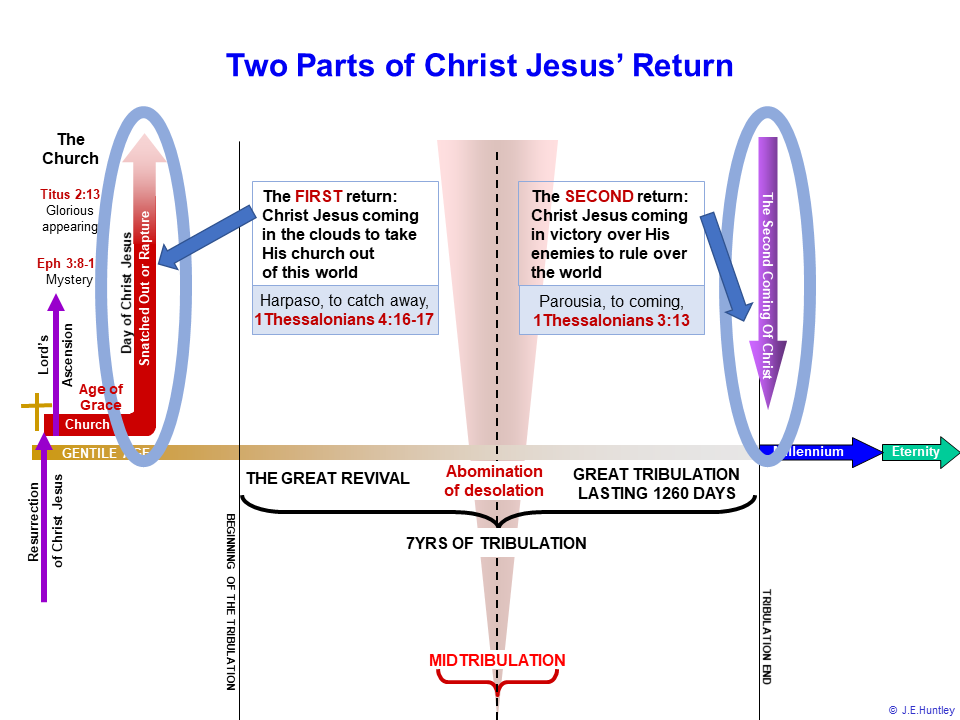
Scriptures describe two resurrections. The first resurrection is for the righteous, John 14:1-4, Titus 3:7, Daniel 12:2-3, 13, and the second resurrection is for the unrighteous who will appear before the great white throne judgment, Revelation 20:11-15, John 5:28-29. The second resurrection is when everyone ever born in this world who did not believe on the Lord Jesus Christ for their salvation. These individuals are destined for eternity in the lake of fire with the Antichrist, the false prophet, and Satan, Revelation 19:20, Revelation 20:10. More information on this topic is available on this site on the second resurrection.
The intent of this web page is to focus on the first resurrection. More information on the resurrection and the comparison between the righteous and unrighteous is found on this website on 1Thessalonians 5. For the church, it is directly related to the rapture of the church. There are three parts to the first resurrection of the righteous:
- First, Christ Jesus was the first in the resurrection, Matthew 27:51-53, and immediately afterward on the same day, many other Old Testament saints were also resurrected with the Lord as first fruits, 1Corinthians 15:20-23
- Second, the resurrection of the church (believers in Christ Jesus who died after the resurrection of the Lord), both the little flock and the Body-of-Christ, followed by the snatching away (rapture) of those in the Body-of-Christ who are still alive when the Lord appears in the clouds to call up those who are His, 1Thessalonians 4:16
- Third, the Old Testament saints’ resurrection will occur after the wrath of the Lord is poured out upon the World, Job 14:10-14. They will be present when the Lord establishes His millennial kingdom after the battle of Armageddon, Daniel 12:2-3, 13, and the tribulation saints who were slain, Revelation 20:4
Jesus spoke of the resurrection of the Old Testament saints in John 5:24-30, which is the same as in Daniel 12:1-3. Concerning the resurrection of the church, after Judas left the upper room to betray Jesus, then the Lord stated among the faithful, that now He was glorified, John 13:30-32, and that is when he gave the commandment to His church to love one another, John 13:34-35. Later that same evening, the Lord promised His disciples of His return for them, who represent the church as its early elders, John 14:1-7, and to take them to a place prepared for them.
The following graphic illustrates the three parts of the first resurrection, by the rose-colored boxes, and the timing of the 2nd resurrection, in the black oval.
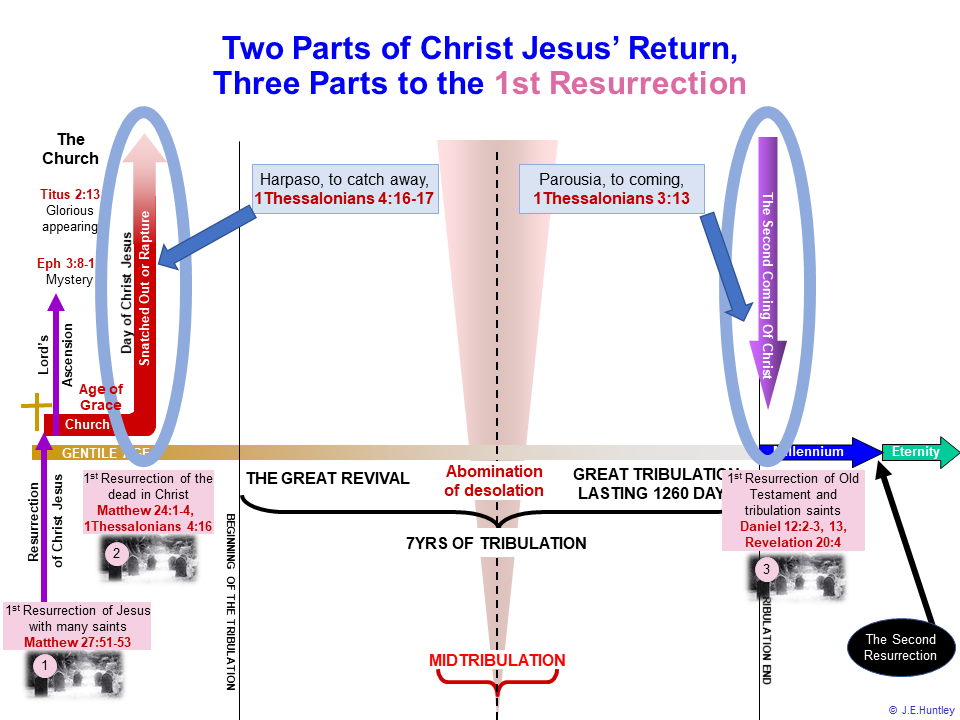
The strength of the gospel of Jesus Christ, 1Corinthians 15:3-4, is the Lord’s resurrection, 1Corinthians 15:12-20. Our hope as Christians is in the Lord Jesus Christ, who is the firstfruits of the resurrection (more information on the resurrection is provided on 1Corinthians 15 on this website). At the time of His resurrection, He also resurrected other saints who appeared in Jerusalem, a further proof of this mighty act of God, Matthew 27:51-53. This is different than the miracle the Lord performed at the tomb of Lazarus, John 12.1-44. Lazarus, including all others who were also raised from the dead, all died again. The Lord and those whom He resurrected with him, are all alive today in the presence of the Lord, 2Corinthians 5:6-11. After Christ’s resurrection, he appeared to many for 40 days, proving that He was alive, Acts 1:3-5. The ascension of Christ occurred after He told the apostles that it was not for them to know the times or dates set by the Father for His return. The Lord was then taken up and a cloud hid Him from their sight, Acts 1:6-9. Two angels suddenly appeared among them, saying that Jesus will return in the same way, in the clouds, Acts 1:10-11. The return of the Lord to call up His church to Himself in the air, 1Thessalonians 4:17, is intimately tied to the resurrection of those who have died in Christ, 1Corinthians 15:51-57. Paul is emphatic in his writing that flesh and blood will not inherit the kingdom of God, 1Corinthians 15:50. Therefore, believers in Christ Jesus who are still physically alive at the moment when Christ Jesus returns in the clouds, are the ones who will be translated from their physical bodies to their eternal bodies to be with the Lord. As Paul puts it, we will not all sleep, but be changed, in the twinkling of an eye, at the last trumpet, 1Corinthians 15:51-53. The sound of the Lord's voice is described by Paul and others as a sound of the trumpet, Revelation 1:10-11, Exodus 19:16-20. Upon the call of the Lord, the dead in Christ will be raised imperishable, those that are alive will be changed, and we will all be clothed with the imperishable and with immortality. Death will be swallowed up in victory. As a result of all this, the Christians are encouraged to stand firm, and give ourselves fully to the work of the Lord, which is not in vain, 1Corinthians 15:55-58.
In Paul's epistles to the Thessalonians and the Corinthians, the subject of the rapture of the church is exactly the same. Concerning those who have passed away in Christ, we have hope because of the resurrection of Jesus. Paul reminded the Thessalonians who were concerned about those who died in Christ, that that God will also bring them with Christ, 1Thessalonians 4:13-14, when he returns in the clouds for His own. According to the Lord’s own words, 1Thessalonians 4:15, those who are alive at His return will not proceed those who have fallen. The Lord will come down from heaven, 1Thessalonians 4:16, with a loud command. With the voice of the archangel and with a trumpet call of God, those who are dead in Christ will rise first, then we who are alive will be caught up together with them in the clouds, 1Thessalonians 4:17. We will meet the Lord in the air, and then be with the Lord forevermore.
Christians, believers in the Lord Jesus Christ, are given the promise of the imminence of the return of the Lord in the clouds to call His church up to Him, 1Thessalonians 4:13-17, Titus 2:13, and we are to encourage ourselves with these words from the Lord, 1Thessalonians 4:18. Another word of encouragement to the church is that we are not appointed to suffer wrath, but to receive salvation through Jesus Christ, Romans 5:9, 1Thessalonians 1:10, 5:1-11. God is rewarding those in the church with the crown for righteousness to those who long for Christ’s appearing, 2Timothy 4:8. The wrath of God the Son (the Lamb), Revelation 6:16-17, and of the Father, Revelation 16:1, are associated with several events, which the church will not have any part of:
- The opening of the 6th seal, Revelation 6:16-17
- The blowing of the 7th trumpet, Revelation 11:18
- The announcement of the third of seven angels warning the world about the permanent consequences if any person worships the beast and his image, and receives his mark on his forehead or on the hand, Revelation 14:8-10, 19
- The voice from the temple telling the seven angels to pour out the seven bowls of God’s wrath, Revelation 16:19
- The return of Christ with a sharp sword out of His mouth to smite the nations, rule them with a rod of iron, and treading the winepress of the fierceness and wrath of Almighty God, Revelation 19:15
This site concludes that based on the preponderance of the scripture that are cited throughout this site's pages, that the best interpretation concerning the snatching away of the church, or “rapture” as commonly referred to, is that it will occur before the beginning of the seven years of tribulation. Other well-learned brothers and sisters in Christ have alternate views, and which should not be the focus of great debates that lead to fissures within the fellowship in Christ. Rather, through respect and love, as the Lord commanded in John 13:31-35, the differences are acknowledged but are not elaborated upon in this site. There is more information on three of the three views on prophesy.
Another view, the pre-wrath view does not readily map over these timelines, as this view holds an entirely different prospective of how the eschatological events will unfold, and that God's wrath will occur at the very end of the tribulation. In their view, the church will be raptured just before that event occurs. This group of believers in Christ, view that a parallel of the events revealed by the Lord during the Olivet Discourse and the seven seals are what dictate the unfolding of events during the tribulation. The opening of the 5th seal will constitute the beginning of the great tribulation. The 6th seal will, in their view, occur near the end of the second half of the tribulation, the Lord will return, and He will rapture the church then. Upon opening the 7th seal, the great wrath of the Lord will fall upon the world and then conclude the seven years of tribulation.
As mentioned above, the preferred interpretation of the passages in scripture relating to the rapture of the church, is that it will occur prior to the beginning of the seven years of tribulation. Within the gray box near the bottom of the chart below, a blue seven-point star indicates the timing of the pre-tribulation rapture, at the end of the church age. There are three other basic interpretations for when the rapture will occur as shown below that can be illustrated with the timelines used in this website. The other three views are shown on this same timeline to aid in illustrating differences in views. However, those who argue in favor of such viewpoints, as do those who endorse the pre-wrath view, may have a different depiction on the timeline for representing the great tribulation and God's wrath. Differences are likely greater than are generalized here, but the graphic below is only an attempt to map the differing views onto a single timeline.
One of these views, shown below, is the midtribulation rapture, second is the post-tribulation rapture, and third, the partial rapture. In just a brief description of each, without elaboration, the midtribulation rapture viewpoint interprets the events in the Olivet Discourse, the seal judgments, the trumpet judgments, and the bowl judgments occurring in parallel. They teach the church will go through the beginning of the tribulation, but will be raptured before the great tribulation commences. The post-tribulation rapture is thought by some who hold this view, that the church will be raptured after the great tribulation, but before the outpouring of God's wrath. Finally, those who believe in a partial rapture, believe that those who are ready before the tribulation begins will be raptured, then the remainder will be raptured at other times during the tribulation. The former descriptions are only anecdotal for brevity, and not intended to reflect on the sincere and in-depth work done by those who have adopted any of these viewpoints.
Again, this site promotes the viewpoint of a pretribulation rapture of the church, for many reasons which are cited throughout this website. It might be best summed up in one sense, by the Apostle Paul's admonition to the Thessalonians, that they were to comfort on another with the words concerning the imminent rapture of the church, 1Thessalonians 4:18. It would not appear that much comfort would exist if the church had to look forward in time through all the horrors of the tribulation, as revealed in Revelation, in order to get to the time of the church's rapture.
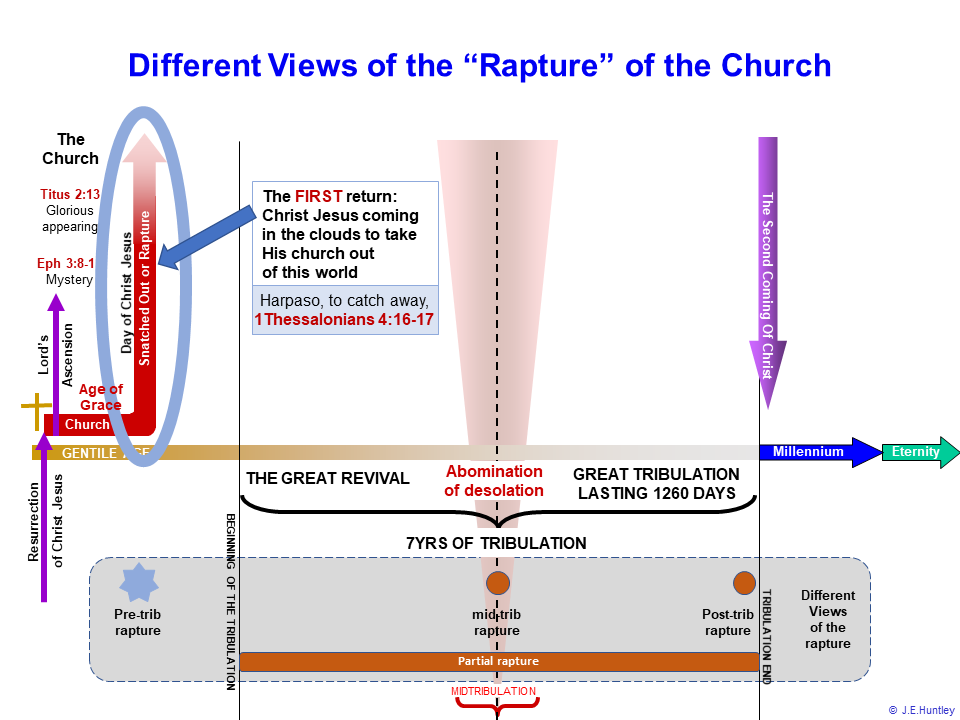
For more discussion on three views concerning Biblical prophecy, the reader is referred to the page on this site on three of the three views on prophesy.
The following illustration is to show, in general, the two pathways every person is faced with in their life. It begins with each person’s birth, where it is appointed unto men once to die, and then the judgment will occur, Hebrews 9:27. The place, time, and judge at the time of judgment is determined by the ultimate decision each person makes concerning their relationship with Christ Jesus. God did not want any to be condemned, but to have eternal life, John 3:15-17.
If any person chooses not to believe, then their course into eternal life is already set down the unrighteous path on the left side of the illustration, where all men are condemned already because of their unbelief, John 3:18-20. The Lord is not willing that any should perish, but that all should come to repentance, 2Peter 3:9. So those who choose the unrighteous path, go to hades after their physical death, waiting for the time they will appear before the great white throne judgement, where the Lord Jesus Christ is judge, John 5:22, and then they are thrown into the lake of fire for eternity.
Those who choose to believe in Christ Jesus, will follow the righteous path on the right side of the illustration. All who believed in Christ Jesus following His resurrection, Romans 4:25, are justified, will appear before the judgement seat of Christ, or His bema seat. There, all the works of those saints will be evaluated by fire, so that those who build their life on the foundation of Jesus Christ, will receive a reward, but those who do not, will suffer loss, but they will still be saved, 1Corinthians 3:11-15. Afterwards, following the tribulation, Revelation 20:4, and after the end of the age, Revelation 20:7-10, the righteous will be translated into their eternal bodies and enjoy eternity future with God the Father and God the Son in the new heaven, new earth and new Jerusalem forever, Revelation 21:1-3.
